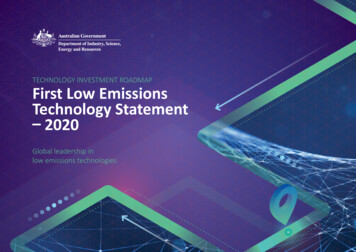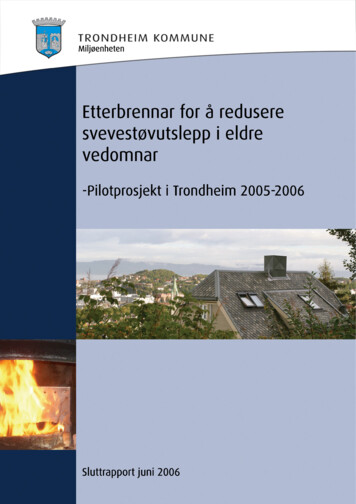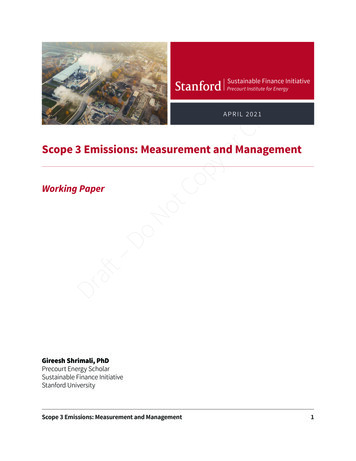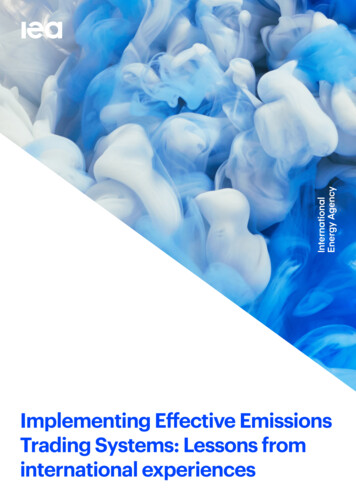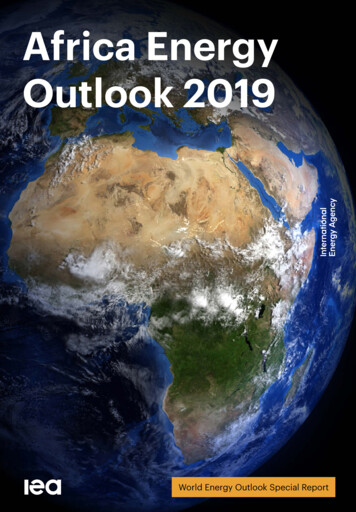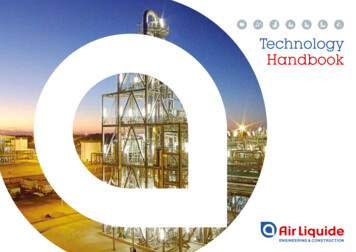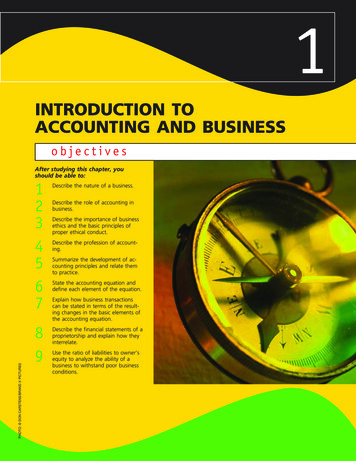
Transcription
Reducing CO2 emissionsfrom heavy-duty vehiclesAN INTEGRATED APPROACH
1. WHAT PROGRESS HAS BEEN MADE?Transport is currently responsible for around a quarter of totalgreenhouse gas emissions, with road transport representing17.8% of total emissions, arising from the use of vehicles.Of this, all heavy-duty vehicles in Europe combined accountfor 5% of Europe’s greenhouse gas emissions, while theyare responsible for carrying 75% of all land-based freight.As a comparison, energy supply is responsible for 30% ofemissions and industry for 19%.Sources ofgreenhouse gasemissions in Europe5% heavy-duty vehiclesThe truck industry remains committed to continuing to30%energysupplylower greenhouse gas emissions through more fuel-efficienttechnology (such as common rail injection, GPS-basedautomated gearboxes, highly-efficient exhaust after-treatmentsystems). This comes in addition to further improvementsof combustion and air handling, aerodynamics, low rollingresistance tyres and advanced control systems.Transport of freightover land in Europe75% heavy-duty vehicles25%transport19%industry18% rail26%other7% inland waterwaysBetween the early nineties and 2013, the main focusof policy makers and the industry was on achievingdramatic decreases in pollutant emissions, such as NOxand PM. To that end, six sets of ‘Euro’ standards wereintroduced in just over 20 years.g/kWhPollutant emissions have been slashed to near-zero levels1086Euro I0.6Euro IIEuro IIIEuro IVEuro VEuro VINOx0.5-95%0.30.44As a result, pollutant emissions from the latestEuro VI heavy-duty vehicles have been slashedto near-zero levels.2PM0.2-98%0.11991However, it should be understood that reducingpollutant emissions requires conflicting measures toreducing CO2 emissions. This ‘technological trade-off’made it extremely difficult to decrease CO2emissions simultaneously.1996 20002005NOxCO220082013CO2NOx-Further reducing CO2 emissions from heavy-duty vehiclesPer tonne transported, this innovation has resultedin a fuel consumption of as little as nearly one litreof fuel per 100 tonne-km, delivering a significantreduction of CO2 emissions.10098CO2 emissionsWith the major investments in reducing pollutantemissions behind it, the industry then shifted focusto reducing CO2 emissions and succeeded inreducing fuel consumption by about 8% over the lastfive years.CO296-8%949290201120122013201420152016Data: Lastauto Omnibus, Trucker Magazine & Green Truck Award
2. WHY IS THE TRUCK MARKET SO COMPLEX?The end-use or ‘mission’ of trucks varies widely – theymay for instance be used for long-haul or regionaldelivery, for construction or for municipality use.Depending on their mission, most trucks are custombuilt on an individual basis in order to meet specificrequirements, from the number of axles to the size of theengine and fuel tank, to the size of the cab or the heightof the chassis.Furthermore, when we take the complete vehicleinto account – the rigid body or a tractor plus trailer– the heavy-duty vehicle market becomes even morecomplex. There are literally thousands of shapesand sizes of trucks.There simply is no‘one-size-fits-all’ approachfor heavy-duty vehiclesAny strategy to reduce CO2 emissionsfrom heavy-duty vehicles has to take accountof the key features of trucks: he shape of the vehicles, which depends on theirTdaily ‘mission’. he same tractor or engine may end up pulling veryTdifferent trailers and combinations, affecting theCO2 emissions of the complete vehicle. T he usage pattern of the vehicles and their cargo,in other words, ‘the work they do’.KgIs the payload heavy or light, large or small?Is the road flat or hilly? Will the vehicle travel over a long distancein one go, or is the journey short withmany starts and stops? All these variables result in different CO2 emissions.Considering the complexity of the truck marketwith several thousand shapes and sizes, introducinglegislation suitable for all variations is extremelychallenging. There simply is no ‘one-size-fits-all’approach for heavy-duty vehicles.Trucks are not ‘big cars’. CO2 reduction policy for heavyduty vehicles should therefore not follow the sameapproach as that for passenger cars.
3. BRINGING THE MOST FUEL-EFFICIENTVEHICLES TO THE MARKETWhy is fuel efficiency so important to the truck customers?Operating costs of a truckRoad tax: 2%Depreciation: 10%Vehicle insurance: 6%Interest: 2%Overhead: 18%Tyres: 1%Wages: 26%Repair andmaintenance: 5%Fuel: 30%Trucks and buses are economic goods, whichmakes fuel efficiency a key element in thepurchase decision.Fuel represents around 30% of the running costs inthe transport sector. Given the competition betweentransport service providers for goods and people,strong economic incentives exist for fuel efficiencyimprovement.How will customer information be improved with VECTO?Giving customers transparent and reliable fuel consumptioninformation based on a common testing method will allowthem to select the most CO2-efficient vehicle.Since 2010, the European Commission has been workingclosely with the industry on a computer simulation tool(VECTO), which will model CO2 emissions from a widevariety of complete truck and trailer configurations.This means that VECTO will be able to reflect thecomplexity of the heavy-duty vehicle market, as it takesEU market, using this VECTO tool.This CO2 certification has a lot of potential to significantlyreduce CO2 emissions from trucks, as it provides a credible,standardised way of comparing fuel efficiency. It will lead toincreased transparency and competition among manufacturers,driving the market uptake of the cleanest vehicles.Before setting the direction for future CO2 reduction policy,we first need to have a clear understanding of the baselinethe variables into account that affect the CO2 emissions– reflecting today’s level of truck CO2 emissions.of complete vehicles.VECTO is a necessary tool to close this knowledge gap. It isThe upcoming EU legislation on the certification ofessential that policy makers give time to analyse the impactCO2 from heavy-duty vehicles will require a mandatoryof this data collection and certification procedure beforedeclaration of CO2 values for each truck produced for theconsidering setting CO2 limits for heavy-duty vehicles.CUSTOMER BENEFITS12VECTO gives customers transparent and reliablefuel consumption information.VECTO allows customers to compare the CO2and fuel efficiency performance of vehicles fromdifferent manufacturers.This means that transport operators can choosethe most fuel-efficient vehicle more easily, helping themto lower the cost of running a fleet.3The customer receives certified CO2 values for eachtruck purchased.SOCIETAL BENEFITSWhen it comes to society at large:12VECTO stimulates innovation and competition amongmanufacturers to develop the most fuel-efficient vehicles.After all, end-users will be able to compare the offerings ofdifferent manufacturers by using VECTO results.VECTO provides a credible, standardised way of comparingfuel efficiency. It will also give a clear picture of progress inreducing CO2 emissions from trucks.Hence, VECTO ensures that the most fuel-efficient vehiclecombinations are brought onto the market, thereby significantlyreducing CO2 emissions from trucks.
4. HOW CAN MORE SIGNIFICANT CO2 REDUCTIONSBE MADE IN THE FUTURE?In 2008, the commercial vehicle industry made acommitment to reduce fuel consumption from newvehicles by 20% by 2020, compared to 2005. A recentstudy by Transport & Mobility Leuven (TML)1, confirmedthat the industry is on track with reaching this target.However, the technology of new vehicles is just part ofa bigger picture. Firstly, because new vehicles representsuch a small fraction of the fleet, it is important to lookat the entire vehicle fleet rather than just new vehicles.Secondly, there are many more factors than just thevehicle alone that determine CO2 emissions – suchas permitted vehicle length and weight, trailer designs,alternative fuels, driver behaviour, transport operations,infrastructure, or a better utilisation of the vehicle (forexample load optimisation), to name a few. A trulyintegrated approach would draw on this full spectrum ofsolutions to reduce CO2 emissions more effectively.The TML study quantifies for the first time the reductionpotential of this integrated approach, and estimates thepotential gains to be more than double the CO2 reductionrate from a ‘vehicle only’ approach. The overall results of thestudy were validated by a consortium of 15 stakeholderswho, together with truck manufacturers represent thedifferent components of the integrated approach.A truly integratedapproach would draw on the fullspectrum of solutions to reduceCO2 emissions more effectivelyPILOT PROJECTSThe integrated approach is not just a theoretical concept, truck manufacturers have demonstrated thepotential of these measures in real-life conditions.Transport Lab-50%For five years, Transport Lab ran a fleetof some 25 vehicles from Sweden toHolland, implementing all measures thatcan help to reduce emissions – from vehicles andlogistics, to driver training and alternative fuels.This test fleet achieved fuel consumptionreductions of a full 50% between 2008 and 2013.AerodynamicsTelematicsLogistics planningMaintenanceDriver trainingBiofuelsEfficiency RunBy looking at all parts of a vehicle and trailer rather thanfocusing on a single component, the Efficiency Runtests found that each truck consumed around 12% to14% less fuel than standard vehicles in each fleet.Tyres1PredictivePowertrain ControlAerodynamicsThe tests also investigated the potential oflong combination vehicles, and found that fuelconsumption was reduced by around 17% comparedwith standard semi-trailer combinations.-12%to 14%-17%Long combination vehiclesGreenhouse gas reduction measures for the road freight transport sector, Transport & Mobility Leuven, July 2015
5. MEASURES TO COMBAT CO2 MORE EFFECTIVELYAlternative fuelsVehicle-relatedImproving the aerodynamiccharacteristics, for example, caneffectively contribute to bringing CO2emissions down by 3% to 4% by 2020 whencompared to 2014 – of which 1.5% to 2% cancome from the trailer.Low rolling resistance tyres canbe retrofitted to any vehicle at littlecost and provide fuel efficiencyimprovements up to 4%.-4.8%Operations2XFor instance, second-generationbiodiesel is twice as efficientas common diesel.The additional reduction potential ofbiofuels by 2020 (compared to 2014) isestimated to be 0.5% to 1.4%. In the longterm, biofuels have the potential to realise a muchhigher reduction, but there is great uncertaintyabout how fast technology will advance and towhich extent their increased usage will reduce(well-to-wheel) CO2 emissions.Gaseous fuels hold significant potentialto cut CO2 emissions. Engines runningon compressed natural gas, for example,can reduce CO2 by 10-15% on a per-vehicle basis.However, the market share of gas vehicles remainslow for the moment, given the current lack ofrefuelling infrastructure.One of the most prominent candidates7%for a ‘quick win’ is driver training.At a minimal cost, the potentialreduction can be as high as 7%.Revising maximum weights anddimensions to allow for the cross-border,EU-wide use of high-capacity vehicles,such as the European Modular System (EMS).Better road infrastructure managementand maintenance (think for exampleof improving the rolling resistance ofroads or optimising traffic flows) can reduce CO2emissions by 4%.Smart and connected transportnetworks using intelligent transportsystems hold great potential, forinstancetruck platooning.-16%-0.5%Fleet renewalThe automobile industry has succeeded intransforming both engines and many othercomponents to increase fuel efficiency and reduceemissions from new vehicles.But the impact on total emissions from roadtransport is only felt when someone replaces an oldvehicle with a new one (fleet renewal).Besides the fact that fleet renewal is the most costefficient and, in practice, the quickest way to reduceemissions, it also stimulates consumption in Europe,which is one of the key drivers of GDP growth.
EMSIN FOCUSThe European Modular System (EMS)Revising maximum weights and dimensions ofheavy-duty vehicles has great potential. For instance,the EMS has proven to be successful in all countrieswhere it has been implemented: Denmark, Finland,the Netherlands and Sweden – with successful testsunderway in Belgium, Germany and Spain.Using existing technology, EMS combinations canreplace three trucks with two, resulting in a reductionin fuel consumption of about 15-25% (withoutsafety being compromised or any damage toinfrastructure). In some cases, safety wasimproved with EMS.dimensions and speed. Therefore, changes to theselegal boundary conditions would bring significantefficiency improvements. For instance, by furtherpromoting a wider cross-border use of longer vehiclecombinations in Europe.-15%to 25%Efficiency is currently constrained by the legalboundary conditions on maximum permitted weight,IN FOCUSTruckplatooningTruck platooningPlatooning is the linking of two or three self-drivingtrucks in convoy.The trucks closely follow each other at a setdistance, using state-of-the art connectivitytechnology and driving support systems. The trucksin the platoon communicate with each other, usingfor exampleWi-Fi technology, enabling them to travel in sync.The vehicle at the head of the convoy acts as theleader. If it brakes, all the other trucks in the platoonalso brake. Reaction time is virtually one-on-one forall trucks.Platooning results in a lower fuel consumptionand increased safety, as the trucks drive closertogether at a constant speed, with less braking andaccelerating.Truck platooning has the potential to reduce CO2emissions by around 10%.-10%
6. HOW DOES THE EU COMPARE TO THE US?As European manufacturers are global players, they also produce trucks for the American,Chinese and Japanese markets. EU truck manufacturers implement the latest and besttechnology, wherever customers are asking for it.However, it is difficult to compare the CO2 emissions ofEU and US trucks. This is because trucks are designedfor their market-specific use, and freight efficiency ismostly determined by legal boundary conditions, whichdiffer between the EU and US.FOR INSTANCE: Maximum speed limits are higher in the US ayload and trailer cargo volume differ significantlyPbetween both marketsI n terms of CO2/g/m³km (volume), EU trucksperform less well simply because US trucks canlegally transport 21% more volumeVolume comparisonIn the EU, efficiency is currently constrainedby the legal conditions on maximum permitted weight,dimensions and speed. Hence, road freight efficiencyin Europe could be greatly improved by changingvehicle legislation.For instance, by allowing the cross-border use oflonger combination vehicles in Europe, which is alreadycommon practice in the US, truck manufacturers wouldachieve a 14% higher fuel efficiency.Moreover, the lack of tractor length restrictions in the USresults in an air drag benefit for American vehicles.Nonetheless, when using the weight metric, ie fuelconsumption per tonne-kilometre (CO2 g/tkm), EU trucksemit 16% less CO2 emissions than US trucks. Thismetric is also known as the ‘work-done principle’, andshows the true transport efficiency.Interior length13.62m16.00mInterior width2.47m2.50mInterior height2.75m2.80mInterior volume92.5m3112.0m3When looking at the fuelconsumption per tonne-kilometre (CO2 g/tkm),EU trucks emit 16% less CO2 emissions than US trucksReducingCO2Together.euCopyright 2017 ACEA All Rights ReservedAvenue des Nerviens 85 B-1040 Brussels Belgium T 32 2 732 55 50 F 32 2 738 73 10 www.acea.beDesigned by ACW, London, UK
Further reducing CO2 emissions from heavy-duty vehicles Data: Lastauto Omnibus, Trucker Magazine & Green Truck Award 1. WHAT PROGRESS HAS BEEN MADE? 30% energy supply 25% transport 5% heavy-duty vehicles 19% industry 26% other 7% inland waterways 75% heavy-duty vehicles 18% rail 10 8

